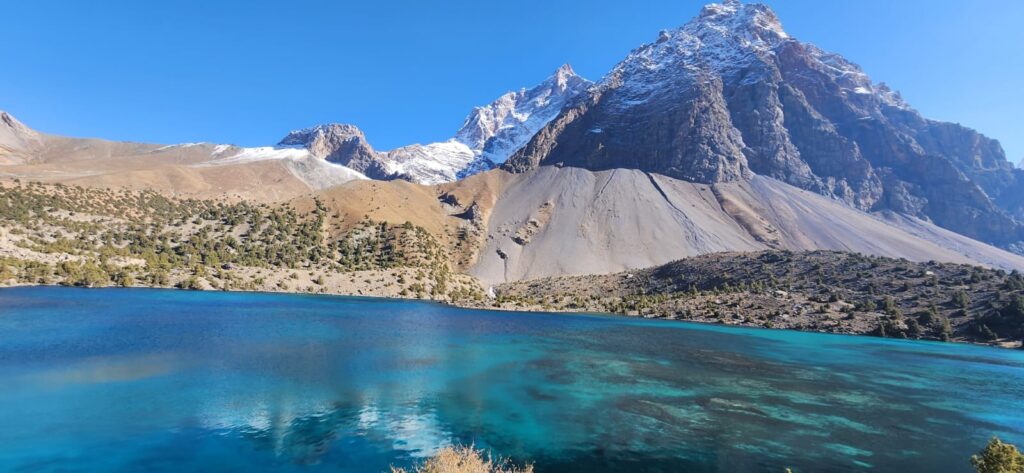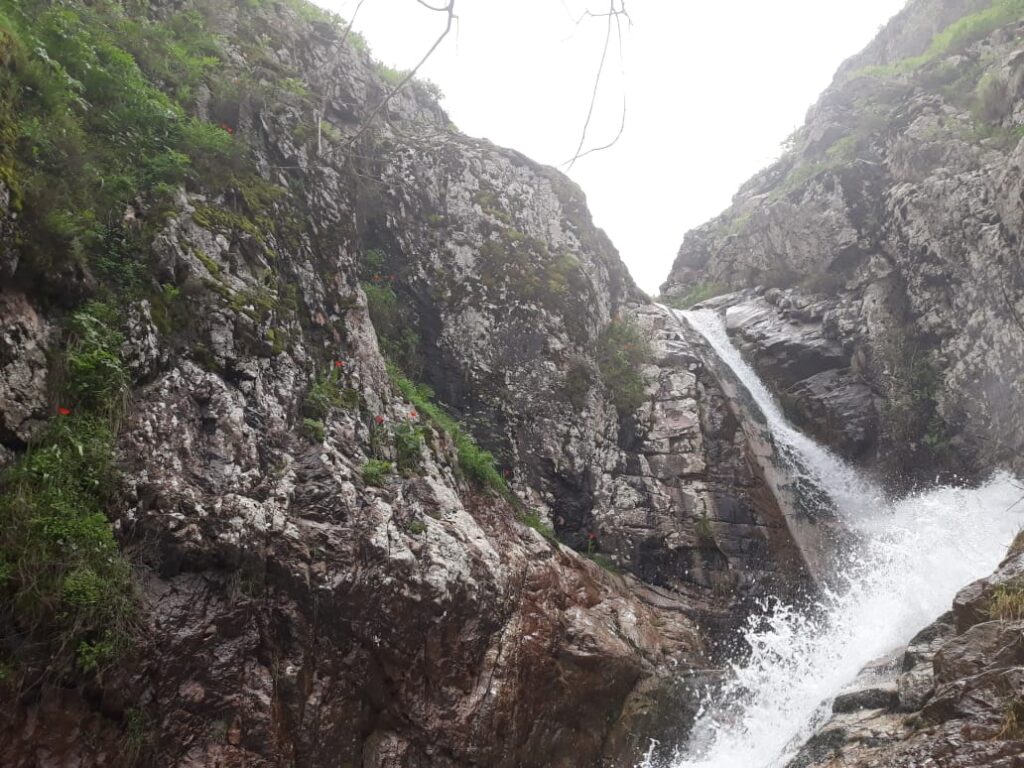High in the Pamirs, where the landscape folds into sharp ridges and cirques, ice is not confined to glaciers alone. Much of it lies hidden within the ground, frozen into the soil and rock. This is permafrost: a perennially frozen ground that has shaped Pamiri landscapes for millennia. Now, under a warming climate, that frozen ground is thawing. The changes are subtle at first: trickles of water where none were before, new depressions forming in alpine meadows, slopes softening under summer heat. Over time, these subtle shifts accumulate into profound transformations of the region’s physical geography.
The Pamirs are among the highest mountain systems in Central Asia, with elevations exceeding 7,000 meters and a cold continental climate that sustains extensive permafrost, particularly above 3,000–3,500 meters. This permafrost exists in a delicate balance with seasonal temperatures and snow cover. Unlike glaciers, which are visible and often studied, permafrost is hidden beneath the surface. It reveals itself through its effects: stabilizing mountain slopes, regulating groundwater flows, and influencing soil formation. In valleys, it acts like a frozen barrier, controlling how water moves through sediments; on slopes, it binds loose materials, contributing to slope stability.
With rising temperatures over recent decades, this frozen layer is retreating. Instrumental records and satellite data show a warming trend across Central Asia, with high-altitude regions warming faster than lowlands (Unger-Shayesteh et al., 2013). In the Pamirs, active-layer thickness- the layer above permafrost that thaws seasonally, has been increasing. Borehole measurements in parts of GBAO reveal temperature increases at depth, indicating progressive thaw. These changes are not uniform; they depend on elevation, aspect, snow insulation, and local geology. South-facing slopes, for example, warm faster than shaded north-facing ones.
The thaw of glacial permafrost is less visible than glacier retreat, but its consequences for the physical landscape are profound. Frozen ground once acted as a structural and hydrological anchor; as it warms, that anchor weakens, altering slope stability, groundwater flow, and surface processes across the Pamirs.
One of the clearest manifestations of permafrost thaw is the increase in active-layer detachments and shallow landslides. In permafrost terrains, thawing reduces cohesion in ice-cemented soils and regolith, allowing gravity to initiate small slides during warm summers. Regional observations across Central Asia since the 1980s–2010s report thickening active layers and thaw-related slope instabilities in the periglacial belts of the Pamir–Tien Shan (Gorbunov, 2013; Marchenko, Gorbunov & Romanovsky, 2007; Stoffel & Huggel, 2012). These failures may be modest individually, but together they raise sediment loads in headwaters and feed downstream debris-flow hazards.
Permafrost also exerts a critical control on hydrology. In cold mountain catchments, frozen ground can act as a semi-impermeable layer, directing meltwater along surface or near-surface pathways and sustaining summer baseflows. As permafrost thaws, these pathways change. Some areas experience increased infiltration, leading to drier surface conditions and reduced streamflow late in the season; others develop new springs as thaw liberates previously frozen groundwater. Hydrological monitoring in several Pamir catchments has recorded earlier peak flows and shifts in baseflow timing, partially attributed to permafrost degradation (Sorg et al., 2012). This affects not only local ecosystems but also downstream irrigation systems that depend on predictable summer flows.
The interaction between permafrost and glaciers complicates these dynamics. Many Pamir glaciers are polythermal, with permafrost surrounding and sometimes underlying them. Thawing permafrost can destabilize glacier margins, contributing to increased meltwater release and, in some cases, glacial lake expansion. Several small proglacial lakes have grown rapidly in recent decades, partly due to ground-ice melt beneath moraine dams. These lakes can pose sudden flood risks if their natural dams fail.
In remote valleys, thaw also reshapes soils and vegetation. Alpine meadows underlain by permafrost often develop hummocky microrelief as thaw progresses unevenly. Some areas become waterlogged as ice-rich layers melt and ground subsides; others dry out as drainage improves. These shifts affect plant communities, soil development, and surface albedo. In certain high basins, satellite imagery reveals expanding patches of bare ground where vegetated slopes once persisted through summer, indicating localized thermokarst development.
Permafrost thaw in the Pamirs links deep subsurface processes with surface transformations. It connects thermal changes measured in boreholes to visible alterations in slope stability, hydrology, and vegetation cover. Geography here operates vertically as well as horizontally, with hidden layers influencing surface dynamics in complex ways.
The pace of change is uneven but accelerating. At elevations near the lower limit of permafrost, thaw is proceeding fastest, producing threshold effects where once-stable slopes fail after a few unusually warm summers. Higher zones remain colder, but increased active-layer thickness is observable even at elevations above 4,000 meters. Researchers monitoring ground temperatures at several Pamir sites have noted temperature increases of 0.2–0.5°C per decade at permafrost depths since the 1980s (Gorbunov, 2013). Such increments may seem small, but in permafrost systems, they can mark the difference between long-term stability and rapid degradation.
For mountain communities, these changes translate into new hazards and altered water availability. Landslides, debris flows, and rockfalls linked to permafrost thaw threaten roads and pastures. Springs shift location or dry up, complicating irrigation and drinking water supply. Because permafrost processes are less visible than glacier melt, their impacts often catch communities unprepared. Traditional knowledge recognizes signs of slope instability: cracking turf, sudden spring emergence but these signs now appear in new places and times.
From a broader geographic perspective, the thaw of glacial permafrost in the Pamirs signals a reconfiguration of mountain systems under climate change. It alters not just physical forms but the processes that maintain them. Slope stability, sediment transport, and hydrological regimes are all being rewritten by changes occurring literally beneath the surface. This is not a distant or future scenario; it is already unfolding across high-altitude Tajikistan, often in places far from regular monitoring.
Standing at the foot of a scree slope in the Eastern Pamirs on a summer afternoon, one can see meltwater trickling unexpectedly from beneath boulders, forming rivulets that disappear into the tundra. Above, turf mats hang askew on a newly opened scarp. Nothing dramatic happens in a single moment, but over seasons, these small changes accumulate, reshaping both land and water.
References
- Gorbunov, A. P. (2013). Mountain permafrost in Central Asia. Permafrost and Periglacial Processes, 24(2), 87–94.
- Marchenko, S. S., Gorbunov, A. P., & Romanovsky, V. E. (2007). Permafrost warming in the Tien Shan Mountains, Central Asia. Global and Planetary Change, 56(3–4), 311–327.
- Sorg, A., Bolch, T., Stoffel, M., Solomina, O., & Beniston, M. (2012). Climate change impacts on glaciers and runoff in Central Asia. Nature Climate Change, 2(10), 725–731.
- Unger-Shayesteh, K., Vorogushyn, S., Farinotti, D., Gafurov, A., Duethmann, D., Mandychev, A., & Merz, B. (2013). What do we know about past changes in the water cycle of Central Asian headwaters? Global and Planetary Change, 110, 4–25.
- Stoffel, M., & Huggel, C. (2012). Effects of climate change on mass movements in mountain environments. Progress in Physical Geography, 36(3), 421–439.








